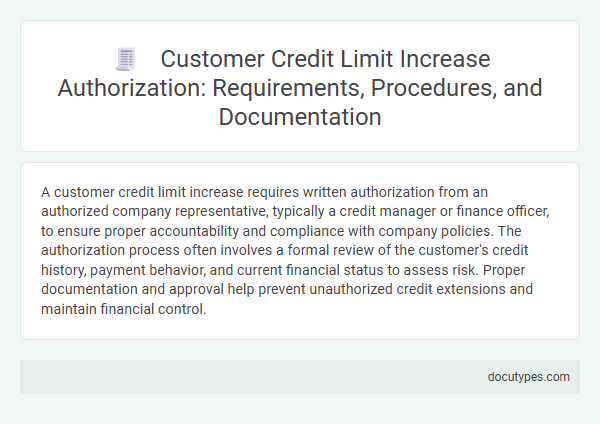A customer credit limit increase requires written authorization from an authorized company representative, typically a credit manager or finance officer, to ensure proper accountability and compliance with company policies. The authorization process often involves a formal review of the customer's credit history, payment behavior, and current financial status to assess risk. Proper documentation and approval help prevent unauthorized credit extensions and maintain financial control.
Understanding Customer Credit Limit Increase Authorization
Authorization for customer credit limit increases ensures financial risk is managed effectively and credit policies are adhered to. Understanding the type of authorization required involves recognizing internal controls and approval hierarchies within the organization.
- Managerial Approval - Typically required for moderate credit limit increases to verify customer creditworthiness and ensure compliance.
- Credit Committee Authorization - Involves a group decision for substantial increases, balancing risk and business growth opportunities.
- Automated System Checks - Utilizes predefined credit criteria and risk assessments to approve routine or small limit increases efficiently.
Key Requirements for Credit Limit Increase Approval
Authorization for customer credit limit increases typically requires approval from designated credit managers or authorized personnel within the finance department. Key requirements include a thorough creditworthiness assessment, verification of the customer's payment history, and alignment with the company's risk management policies. Documentation of the approval process and compliance with internal control standards are essential to ensure transaction validity and mitigate financial risk.
Eligibility Criteria for Customers
Authorization for customer credit limit increases requires a thorough assessment of the customer's financial stability and payment history. Eligibility criteria include a consistent record of on-time payments, sufficient income verification, and absence of recent defaults or bankruptcies.
Credit limit approvals often depend on the customer's credit score, length of relationship with the company, and current outstanding balances. Companies may also consider the customer's overall credit utilization ratio and recent credit inquiries. These factors ensure that the increased limit aligns with the customer's ability to manage higher credit responsibly.
Required Documentation for Credit Limit Requests
Authorization for customer credit limit increases typically requires managerial approval based on established credit policies. The decision depends on factors such as the customer's payment history and current credit utilization.
Required documentation for credit limit requests includes recent financial statements, credit reports, and a formal application form. Supporting documents help assess the customer's creditworthiness and justify the increase.
Step-by-Step Credit Limit Increase Procedures
Authorization for customer credit limit increases typically requires approval from designated financial managers or credit control officers. The process begins with a formal credit review, assessing the customer's payment history and financial status. Final approval is granted only after risk evaluation and compliance with company credit policies.
Roles and Responsibilities in the Authorization Process
Authorization for customer credit limit increases typically involves roles such as credit analysts, account managers, and finance supervisors. Each role holds specific responsibilities to ensure that credit limit adjustments align with company policies and risk management standards.
Credit analysts assess the customer's financial health and creditworthiness, providing recommendations based on data analysis. Finance supervisors or designated approvers review these recommendations and authorize the final credit limit changes, maintaining control and accountability in the process.
Risk Assessment and Credit Evaluation Guidelines
Authorization for customer credit limit increases requires a thorough risk assessment to evaluate the customer's financial stability and payment behavior. Credit evaluation guidelines help determine the appropriate credit limit by analyzing credit history and risk exposure.
- Risk Assessment - Involves analyzing credit score, payment patterns, and outstanding debt to identify potential default risks.
- Credit Evaluation Guidelines - Establish criteria such as minimum income levels and maximum credit utilization rates to standardize limit adjustments.
- Approval Authority Levels - Specify the required management or credit committee approval based on the size of the credit limit increase and associated risk.
Common Reasons for Credit Limit Increase Denial
What type of authorization is needed for customer credit limit increases? Authorization typically requires approval from the credit department or a senior financial officer. This ensures that credit risk assessments and company policies are thoroughly reviewed before any adjustments.
What are common reasons for credit limit increase denial? Credit limit requests are often denied due to poor payment history, high existing debt, or insufficient income verification. These factors indicate a higher risk of default, prompting the need for strict authorization controls.
Best Practices in Documenting Credit Limit Changes
Authorization for customer credit limit increases requires designated approval from financial management to ensure risk is managed effectively. Documentation of these changes is essential for transparency and audit readiness.
- Defined Approval Hierarchy - Establish clear roles and levels of authority to approve credit limit increases based on customer risk profile and credit history.
- Comprehensive Documentation - Record all approval decisions along with justification, date, and approver information in a centralized system.
- Regular Audit Trail Reviews - Conduct periodic audits of credit limit changes to verify compliance with internal policies and regulatory standards.
Best practices in documenting credit limit changes strengthen financial controls and support informed decision-making.
What Type of Authorization Is Needed for Customer Credit Limit Increases? Infographic

